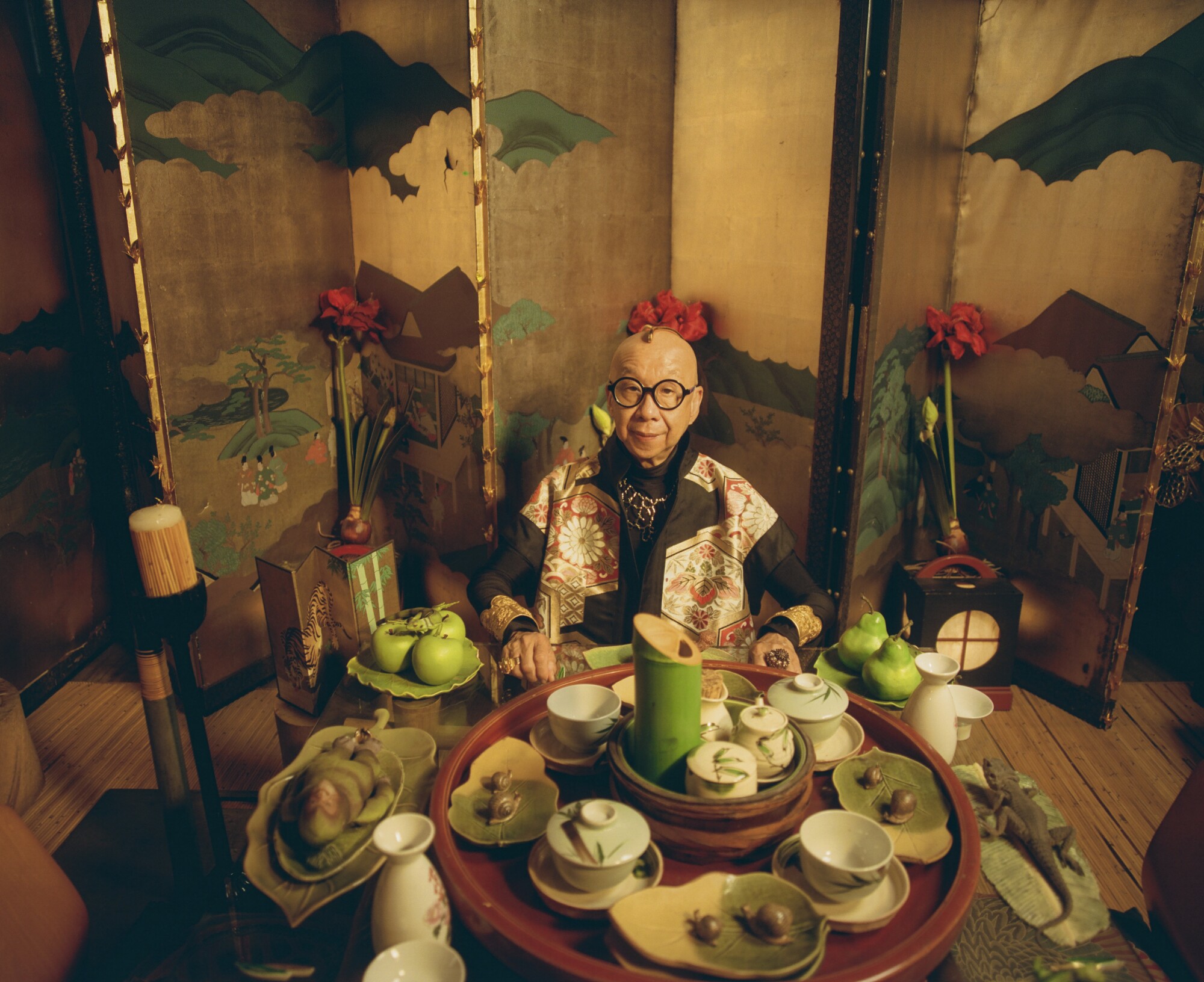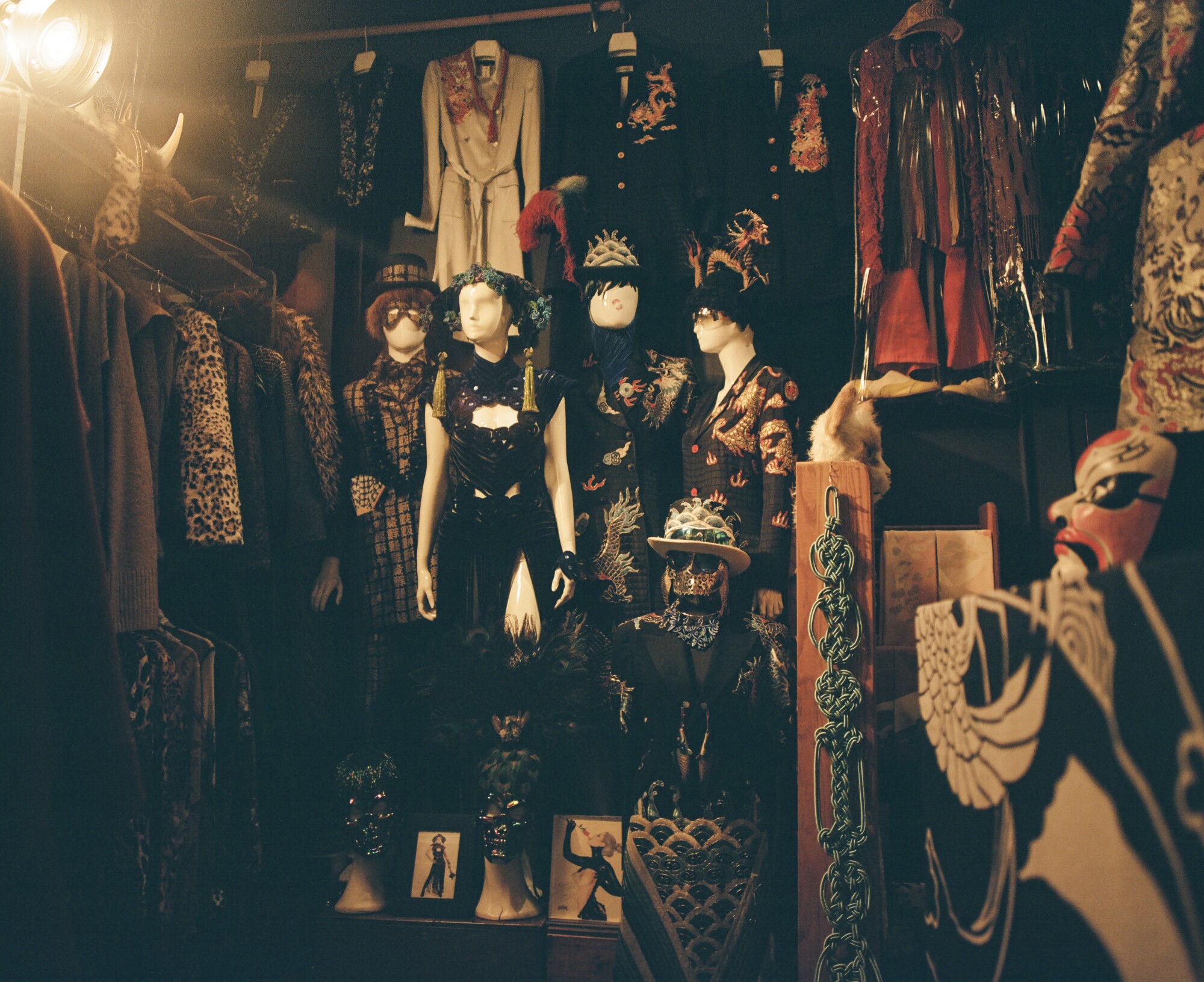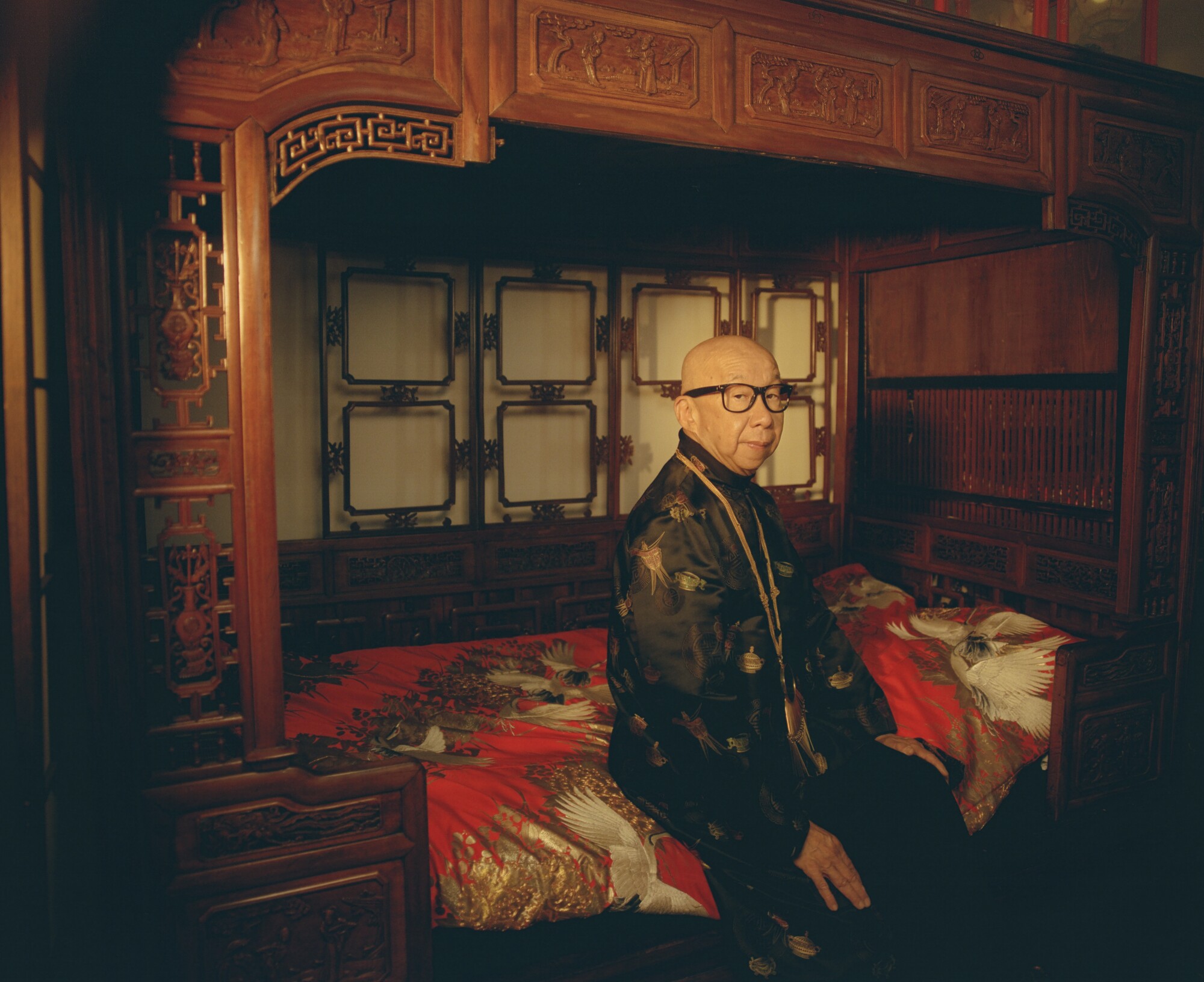Among the lovely objects of L.A. fashion icon Peter Lai

When Peter Lai opens the door to his Arts District loft, he’s wearing high-waisted teal slacks, a seafoam mesh top printed with a dragon, a bright blue cap and cornflower acetate glasses. “The tour is one hour,” he explains, but I’m already lost in the explosion of color and texture, not only in Lai’s outfit but in the eclectic expanse behind him. I spot a rack of handmade cummerbunds sewn out of ornate obi fabric, which is above a cabinet of nearly 100 Italian-made eyeglasses in various geometries, which is next to several laser-cut metal faceplates tied around mannequin heads. A furry cat mask stares out from under an antique kimono.
This is Peter Lai’s Japanese Cultural Village — part studio, part archive, part museum, and also his home. But the best way to experience the dazzling maze of the loft is to let Peter Lai show you himself.
Lai’s belongings are arranged as living art, each telling a piece of his story.
(Samanta Helou Hernandez/For The Times)
The 71-year-old Chinese designer walks me through the Russian doll-like space, which displays one-of-a-kind designs from Lai’s 30-year fashion career as well as his extensive collection of Asian costumes, art, ceramics and antiquities. Absolutely no area is wasted. Above us hang paper lanterns, uchiwa fans, rice paper scrolls and bamboo parasols. All around us are kabuki headpieces, hand-painted kimono fabric, brocade floor-length jackets and geisha dolls frozen inside glass cases. A shoji screen is folded to reveal a closet glowing with Chinese opera costumes. Lai parts the hanging noren curtains to lead the way into a section he calls “the black and diamond area,” filled with his custom black sequined gowns adorned with rhinestones. But this is not chaos. His belongings are meticulously organized by color, texture or provenance, and arranged as living art, each telling a piece of his story.
In the black-and-white section, he moves a plastic skeleton out of the way to show me a wool coat onto which he’s stitched vintage white lace, and a sequined bolero embellished with pearl appliques. “These are for a client,” he says. “It’s already busy for some people, but for me it’s not enough.”
Lai’s story has always been one of maximalism. He was born already immersed in drama, the son of a Hong Kong family that made their living producing elaborate period costumes for television and film. Lai was the only child of seven who worked in the family business, learning the trade at just 12 years old. The rules around ornate Ming and Qing Dynasty uniforms, textiles and patterns were intense but he took to it naturally. His family even used their own home as overflow storage, hanging silk robes meant for long-gone royalty all over the house in a manner not unlike Lai’s current situation. However, it wasn’t until his first trip abroad, to Japan at 21, that he fell in love with that culture and subsequently understood what he was meant to do.

Lai describes his home as “living in a fantasy, a dream.”
(Samanta Helou Hernandez / For The Times)

Lai collects lifelike models of food often used by Japanese restaurants.
(Samanta Helou Hernandez / For The Times)
“There are so many beautiful things there,” he says of his trip to Japan. It triggered a realization that he’d spent so much time in the costuming business constructing clothes according to antiquated dynasty-specific rules, all the while harboring a secret desire to make beauty of his own. To build up his fashion knowledge, he saved enough money to travel to Europe, where he scoured Italy for goods to import back to Hong Kong. Then, suddenly, his father died. This liberated Lai, who had been hiding not only his sexuality but also his ambitions. A budding Japanophile, he wanted to study design in Tokyo but didn’t know enough Japanese. He did know English, though, and had heard of Otis College’s fashion reputation. So with $3,000 to his name and no portfolio, he flew to Los Angeles and convinced Otis to let him enroll part-time in the fashion program while he worked at a restaurant to pay for credits and rent.
“I did have luck,” Lai says. “But I worked hard, from the age of 12 to 62.” He shows me one of his first designs, a black dress coat with a woven gold dragon. “I find this fabric in the trash behind my friend’s studio,” he says, pointing to the brocade. It was eaten away by rats and cockroaches, but Lai saw the gold parts were still intact, glittering in the refuse. He brought the fabric home. “I add more to it. I always add more and more. I like more dramatic.” He wore it to the opening of the San Francisco Opera, where he says he was approached by actor George Hamilton, who asked, “Who are you? With a jacket like that, you must be someone.” Now Lai smiles and says, “I am not handsome, but I wear my designs the best, because I like beauty.”
Thus began the two hallmarks of Lai’s design career: using reclaimed fabric for his elaborate designs, and serving as his own best model. In the 1980s Lai hustled to get his line noticed, peacocking his own creations at industry parties and into Beverly Hills boutiques. It was on one of those trips to a now-defunct Rodeo Drive shop that actress Tippi Hedren spotted him. According to Lai, she asked him to sell her the shirt he was wearing, and became his first celebrity client. After a few years of gaining traction, he felt ready to have a place of his own. He opened his eponymous store on Melrose in 1990, selling his own clothing and jewelry to celebrities like Marla Gibbs, Whoopi Goldberg and Elton John, as well as society women looking for a modern edge.
He later moved the store to San Marino, and says clients continued to come to him there for the same reason they always did. “My clothes were for something different. To stand out. Never boring.” he says. The store marked a major moment in Lai’s life, where, after everything he’d gone through — all the time, risk and hustling — he felt like he’d finally made it. He enjoyed that feeling for over two decades.

“I collect beautiful things,” Lai says. “And now they are all together with me.”
(Samanta Helou Hernandez / For The Times)
And then, in 2013, 50 years after he first began working, Lai closed his store and retired. But, as it turns out, he wasn’t done. Peter Lai’s Japanese Cultural Village was born, though he says it wasn’t in his master plan.
“I never thought I would do something like this, but after all these years, I collect beautiful things,” Lai says as he guides me into the bathroom, where even that space serves as an archive, holding photos of his early life. “And now they are all together with me. Some people have a lot of kids and feel happy when they are all home. I have my things. They are my babies.”
It’s more efficient to live among his collection — everything he needs at the ready should inspiration strike. But as he shows me around, it seems to be about more than just convenience or even attachment. Each object coordinates to a trip he took abroad or to a local antique store, or it connects him to a friend or a client, or it reminds him of a major moment in his career, when someone special picked his designs out of the crowd. And though his career is technically done, the effect of living among all of this is tangible, sparkly proof that he did it: He lived out the dreams of his younger self. And he continues to breathe life into these objects with his daily routine and the tours; his creations keep living. Here, in the Asian Village, the objects and their stories are a testament that there is more life to be had, more outfits to wear, and endless possibilities for beauty. It is Lai’s legacy, and he gets to live it.
So while some might find his way of living claustrophobic, for Lai it’s freedom. “For me, it’s living in a fantasy, a dream,” he says. “I work so hard to make my dream come true. Now I treasure it, because life like that is hard to find, hard to get.”

“I am even more creative now,” Lai explains. “This is the most enjoyable time in my whole life.”
(Samanta Helou Hernandez / For The Times)

Lai’s kitchen is a feast, but only for the eyes.
(Samanta Helou Hernandez / For The Times)
And like a dream, the line between home and art is blurred. A low table surrounded by hutches full of antique Japanese tea sets and rice bowls is set for lunch, but only with sampuru, the lifelike models of food often used by Japanese restaurants. In the kitchen, a reclaimed formica tabletop hosts several dinner settings arranged with intricate chopsticks, delicate Japanese bowls and, of course, plastic Japanese beetles. It’s a feast, but only for the eyes. He gestures to a small, 7-by-7-foot cleared area in the corner of the table. “That’s where I eat,” he says. “But I don’t eat at home a lot. I like to go out.”
Lai sleeps in “the Chinese Section,” tucked into a hardwood opium bed that dates back hundreds of years, under a duvet he sewed out of a red and gold wedding kimono. “But sometimes I don’t sleep because I’m so excited, so I get up with an idea and start playing.”
“Playing” is what he calls the creative process of adding and altering the vintage items he sources. When Lai had his own label, he repurposed textiles he acquired from Japan. But now he focuses more on discovering unusual pieces at antique stores and swap meets, and using his finds to style looks and adorn existing garments. I ask if there is a method to his process, and he simply says, “You have to play to see.”
In a space where everything — even the bed he sleeps in — is inspiration, Lai feels free to finally play for his own pleasure. But this doesn’t mean he’s slowing down. Lai still wears his garments on the party circuit, though he now limits his parties to two a night, max. He began studying kabuki dance with renowned teacher Madame Fujima Kansuma when he was 50, and he still attends class on Saturdays. And he gets dressed every morning as if he’s still that hopeful designer searching for a big break, putting together colorful, flamboyant outfits even during lockdown. “I look at my things every day, and I am even more creative now,” he explains. “This is the most enjoyable time in my whole life.”

Lai sleeps in a hardwood opium bed that dates back hundreds of years, under a duvet he sewed out of a wedding kimono.
(Samanta Helou Hernandez/For The Times)
Before I leave, I ask to see his most prized possession, and he tells the story of a formal kimono sewn with gold thread that was worn by the Japanese empress 60 years ago. It passed through museums and private owners until finally Lai had the chance to bid on it at auction. He takes me back into the corner of a closet, crouches down and pulls a box out from under the flouncy hems of red opera costumes. He unfolds the kimono, which is thick and radiating gold. We’re sitting on the floor, surrounded on every side by the sparkle and beauty Lai always dreamed of making his life. He points to the 16-petal chrysanthemum design sewn into the kimono, the Imperial Seal of Japan, lost for a moment in thought.
“Only empress is allowed to wear that,” Lai says, quietly. “Or princess. But now I own it. I can’t get rid of it. I save it.”
Save it for what? I ask.
Lai doesn’t hesitate. “The future,” he says, of course.
Aja Gabel is a novelist and screenwriter. Her debut novel, “The Ensemble,” was published by Riverhead Books. She lives in Los Angeles with her family.




